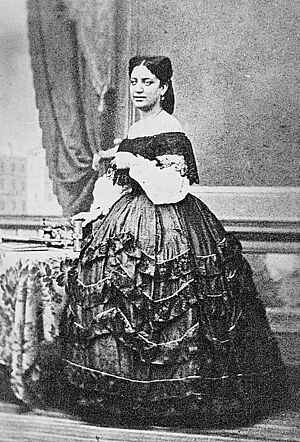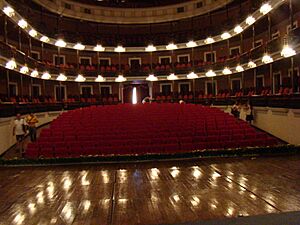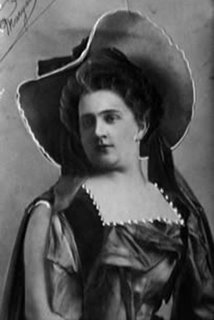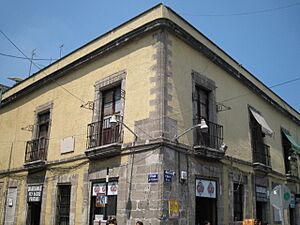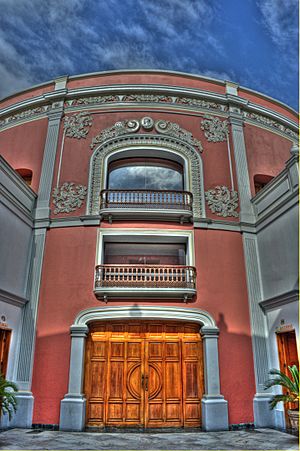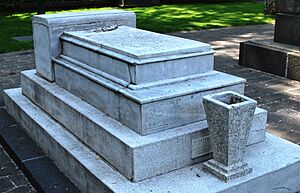Ángela Peralta facts for kids
Quick facts for kids
Ángela Peralta
|
|
|---|---|

Ángela Peralta Castera
|
|
| Born |
María de los Ángeles Manuela Tranquilina Cirila Efrena Peralta Castera
July 6, 1845 |
| Died | August 30, 1883 (aged 38) Mazatlán, Mexico
|
Ángela Peralta (born July 6, 1845, in Mexico City – died August 30, 1883, in Mazatlán) was a very famous opera singer. She was known around the world for her amazing voice. People in Europe called her the "Mexican Nightingale" because she sang so beautifully. By the time she was 20, she had already performed in big opera houses across Europe. Ángela Peralta was mostly known for her singing, but she also wrote music and was good at playing the piano and the harp.
Biography
Ángela Peralta was the daughter of Manuel Peralta and Josefa Castera de Peralta. She showed a special talent for singing and music from a very young age. When she was just 8 years old, she sang a short, beautiful song called a cavatina from an opera by Gaetano Donizetti, and everyone loved it. She then went on to study music at the National Conservatory of Music in Mexico City.
At 15, she made her first big opera performance. She played the role of Leonora in Giuseppe Verdi's Il trovatore at the National Theatre in Mexico City. After this, she traveled to Italy to study singing even more.
On May 13, 1862, she made her debut at La Scala in Milan, Italy. This is a very famous opera house. Her performance in Donizetti's Lucia di Lammermoor was highly praised.
She sang in Vincenzo Bellini's La sonnambula for King Victor Emmanuel II of Italy at the Teatro Regio in Turin. The audience loved her so much that she had to come out for 32 curtain calls! Between 1863 and 1864, she performed in many famous opera houses in cities like Rome, Florence, Bologna, Genoa, Naples, Lisbon, Madrid, Barcelona, St. Petersburg, Alexandria, and Cairo.
In 1865, she was invited to return to Mexico to sing. In 1866, she performed for Maximilian I of Mexico and Charlotte of Belgium. They were the rulers of Mexico at the time, and they named her "Chamber singer of the Empire." In December 1866, she went back to Europe, performing in New York City and Havana on her way.
In Madrid, she married her cousin, Eugenio Castera. For a while, she stopped singing in operas, but she continued to write songs and piano music. Her most famous work is called Álbum Musical de Ángela Peralta. Her marriage faced difficulties because her husband became very ill.
When she visited Mexico again in 1871, Ángela Peralta started her own opera company. She often sang her most famous roles, like Amina in La sonnambula and Lucia in Lucia di Lammermoor. During her life, she sang Amina 122 times and Lucia 166 times!
In the mid-1870s, she faced some challenges and difficulties in Mexico City. This led to a period where her performances were not as well-received by some people. However, her reputation improved after she performed in Linda di Chamounix. She then decided not to sing in Mexico City again.
In 1883, Ángela Peralta began a tour of northern Mexico with her group of Italian opera singers. The tour started in Guaymas and went to La Paz, Baja California Sur. In La Paz, she sang on stage for the last time. She performed the main role in Maria di Rohan in a theater that was made from an old sand pit.
On August 22, her group arrived in the port city of Mazatlán. They were planning to perform Il trovatore and Aida. The city of Mazatlán prepared a big welcome for her. Her boat arrived at a pier decorated with flowers, and a band played the Mexican National Anthem. When her carriage arrived, her fans unhitched the horses and pulled the carriage themselves to the Hotel Iturbide. She waved to the crowds from her balcony.
However, just a few days later, a terrible yellow fever epidemic swept through the city. Ángela Peralta and 76 of her group's 80 members sadly died from the disease.
Ángela Peralta passed away in the Hotel Iturbide in Mazatlán at the age of 38 on August 30, 1883. She married Julián Montiel y Duarte shortly before she passed away. Before her burial in Mazatlán, her body was displayed, dressed in one of her opera costumes and her best jewels. In 1937, her remains were moved to the Rotunda de Hombres Ilustres (Rotunda of Illustrious People) in Mexico City. Both Mazatlán and San Miguel de Allende have theaters named in her honor.
Voice and repertoire
A journalist who watched Ángela Peralta practicing in Mazatlán in 1883 wrote about her voice. He said she had a "wonderful voice that produces notes from the very highest to the lowest with astounding ease." He also mentioned that she sang "several variations with such delicate notes, like the trill of a goldfinch..."
Peralta's wide range of songs and roles included: Leonora in Il trovatore, Violetta in La traviata; Elvira in I puritani; Marie in La fille du régiment; Amina in La sonnambula; Adina in L'elisir d'amore; and the main roles in Aida, Dinorah, Linda di Chamounix, Maria di Rohan, Lucia di Lammermoor, and Norma. She also created the main female roles in three operas by Mexican composers: Ildegonda (1866) and Gino Corsini (1877) by Melesio Morales, and Guatimotzin (1871) by Aniceto Ortega del Villar.
Tribute
On July 6, 2021, Google celebrated her 175th birthday with a special Google Doodle.
Images for kids
See also
 In Spanish: Ángela Peralta para niños
In Spanish: Ángela Peralta para niños


